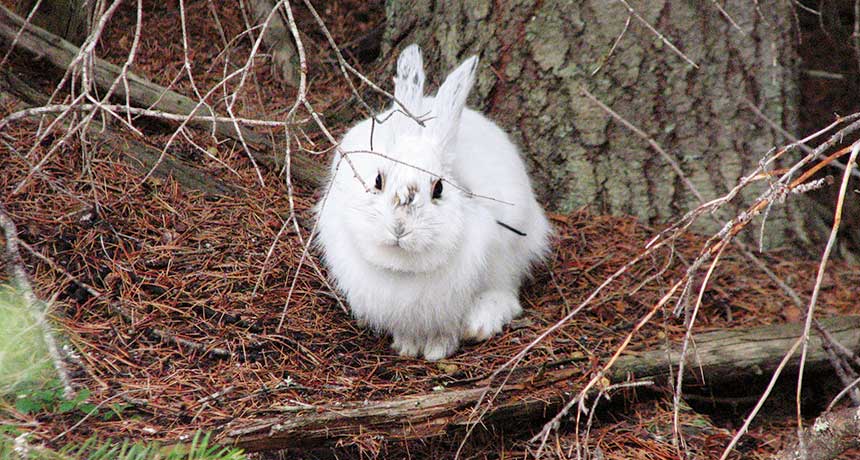Climate change may be deadly for snowshoe hares

When a snowshoe hare stands out against its background, it’s more vulnerable to predators. A new study details just how disastrous this mismatch can be.
L. Scott Mills research photo
- More than 2 years ago
One of the predicted consequences of climate change is that in areas that regularly get snow, that precipitation will arrive later in the winter and melt earlier in the spring.While that may be great for people who hate to shovel, it’s a problem for animals that change their camouflage to match the seasons, such as the snowshoe hare of North America.
Because these animals don’t have control over when they change from dun brown to snowy white, if snow comes later or melts earlier, they may be ill-dressed for the weather. Scientists had suspected that this mismatch could have disastrous repercussions for the animals — and possibly entire species — but they had little data to back that up. Now a new study has quantified the consequences for the snowshoe hare and discovered just how deadly standing out can be.
Marketa Zimova of North Carolina State University in Raleigh and colleagues tracked the fates of 186 radio-collared snowshoe hares at two sites in Montana over three years. They used that data to calculate the cost of a mismatch between coat color and the background landscape. Their study appears January 21 in Ecology Letters.
Snowshoe hares are all brown in the summer and all white in the winter. The transition between the two colors, though, doesn’t happen overnight: The animals go through some period of being a mix of brown and white and don’t completely match the landscape. Also, the timing of the molt isn’t consistent from hare to hare, so some may stand out more than others. This transition period can be deadly because predators, such as lynx and coyote, can much more easily spot their prey.
In the new study, a snowshoe hare that matched its background had about a 96 percent probability of surviving from week to week, the researchers calculated. That probability dropped to 92 percent when hares had a roughly 60 percent mismatch between coat color and background, and to 89 percent when hare color and landscape were completely mismatched.
Those findings mean that a snowshoe hare that completely mismatched its background had a 7 percent lower probability of weekly survival than did one that completely blended in, Zimova and colleagues say.
For now, that’s not such a big deal. On average, each hare experienced less than a week of mismatch. But mismatches could have big consequences later in the century, as snows arrive later and later and spring melts come earlier and earlier. By 2100, the team predicts, the snowshoe hares could experience as many as eight weeks of mismatch, which could lead to a steep population decline.
But there are two ways that the animals might survive the coming change, the researchers note. Individual hares might have enough wiggle room in when they molt that they can adapt to the changes in snow cover — there’s some evidence that this might occur in the spring, though not in fall. Or there might be enough genetic variability among snowshoe hares that the population could evolve the timing of molting. That would let the hares keep up with the changing climate. But scientists can’t predict whether either of these routes will be able to save the snowshoe hares.






